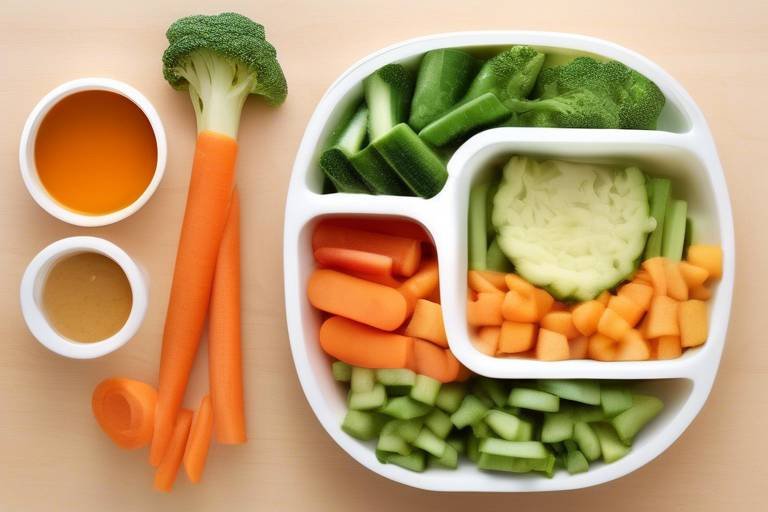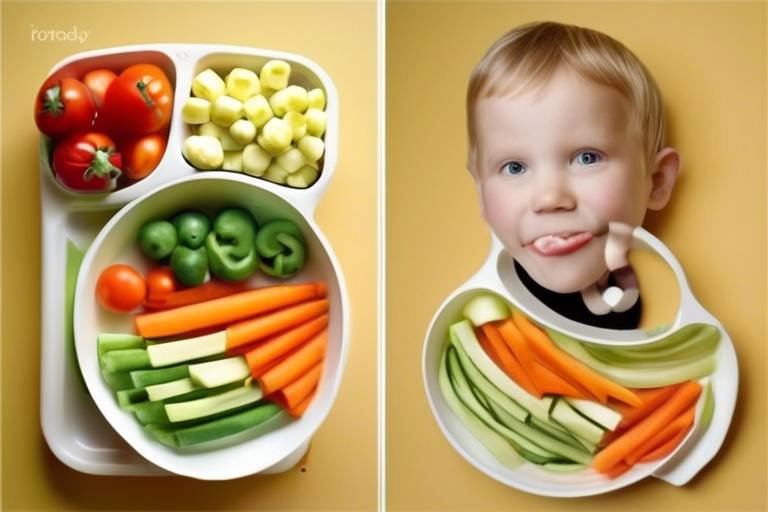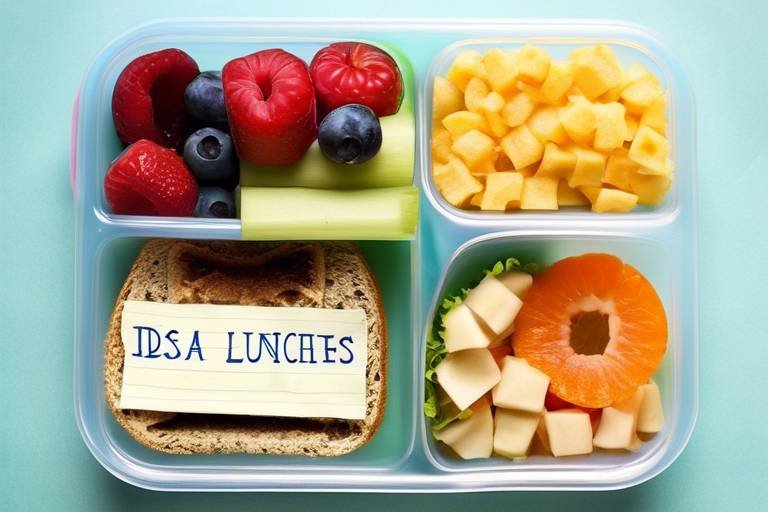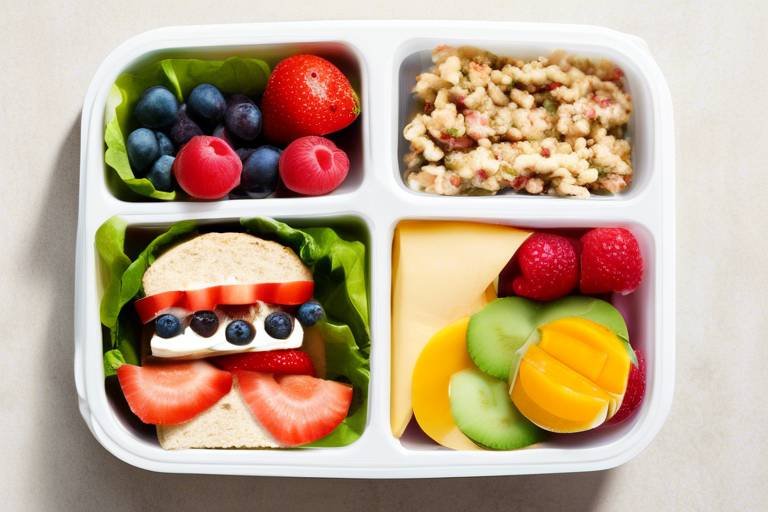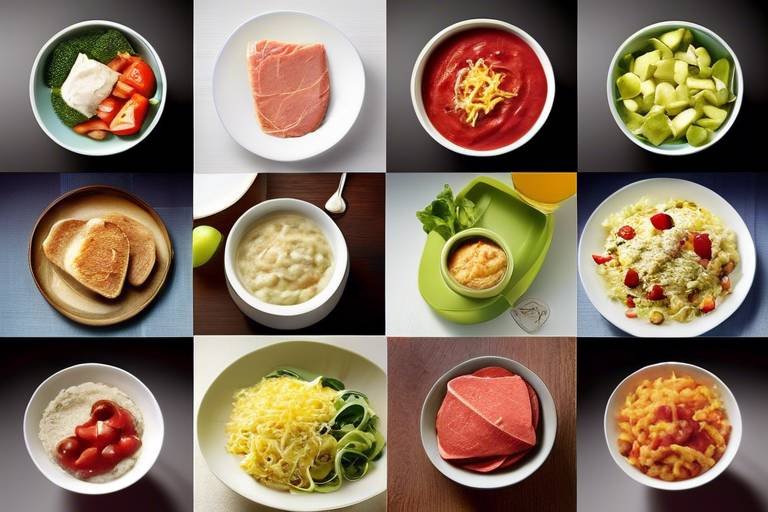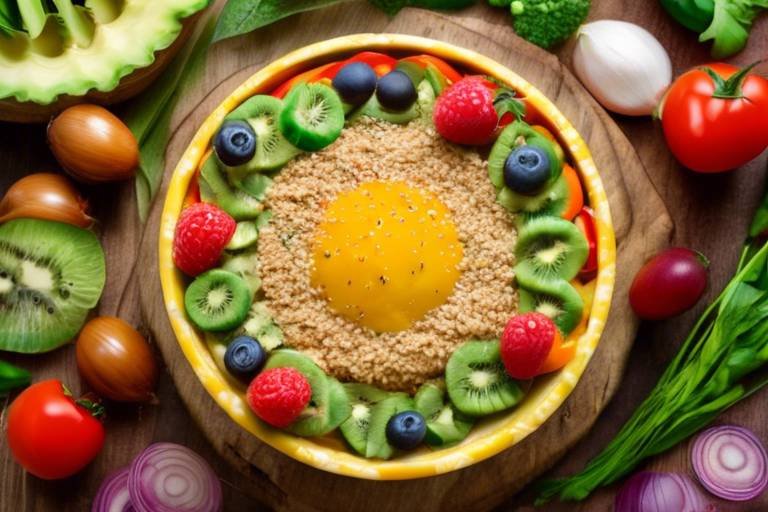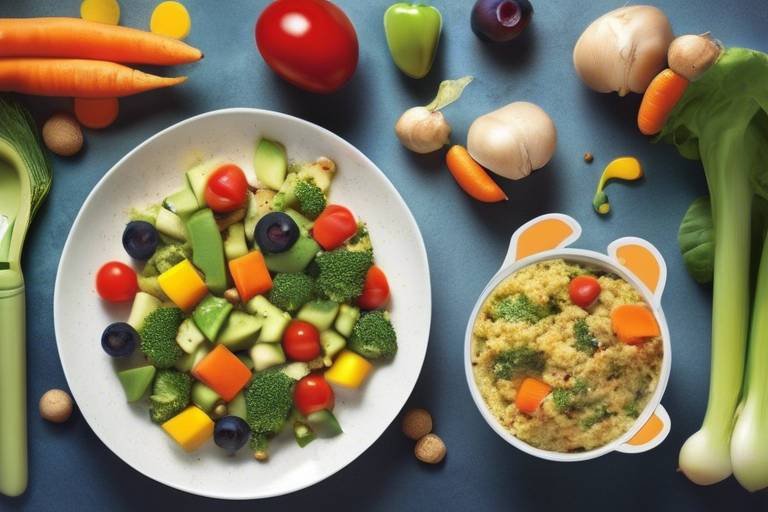Easy Ways to Sneak Veggies into Your Kids' Meals
As parents, we all want our kids to eat healthy, but getting them to enjoy their greens can feel like a never-ending battle. Fortunately, there are some creative and fun strategies that can help you sneak those essential nutrients into their meals without them even noticing! This article explores various methods that will not only satisfy your little ones' taste buds but also ensure they are getting the vitamins and minerals they need to grow strong and healthy.
One of the easiest and most enjoyable ways to incorporate vegetables into your children's diet is through smoothies. Picture this: a delicious, vibrant drink that they think is just a fruity treat, but it's actually packed with healthy greens! By blending fruits like bananas and berries with a handful of spinach or kale, you can create a refreshing beverage that kids will love. Not only do these smoothies taste great, but they also provide a fantastic way to sneak in those vital nutrients. Just remember to keep the ratios right—too much green can be a giveaway!
Transform your family’s pasta or pizza night into a nutritional powerhouse by adding pureed vegetables into your sauces. Imagine a rich marinara sauce that’s not only bursting with flavor but also secretly enriched with carrots, zucchini, or bell peppers. These veggies can easily blend into the sauce, enhancing its texture and flavor without altering the taste significantly. Your kids will be too busy enjoying their favorite dishes to realize they’re consuming healthy ingredients!
When it comes to homemade pizzas, the possibilities are endless. Why not sneak in some finely chopped or grated vegetables like mushrooms, spinach, or bell peppers? They blend seamlessly with cheese and sauce, making it hard for kids to detect them. You could even let your kids help with the pizza-making process, allowing them to choose toppings while you subtly add in those nutritious veggies. It’s a win-win!
If you want to take it a step further, consider using cauliflower or zucchini for your pizza crusts. These alternatives not only add nutrition but also provide a unique taste that kids may find enjoyable. Plus, it’s a fun way to experiment in the kitchen! You’ll be amazed at how well these veggie-based crusts hold up, and your kids will love the novelty of their pizza being made from vegetables.
Another way to make veggies more appealing is to cut them into fun shapes or designs. Using cookie cutters, you can transform ordinary veggies into exciting shapes that entice children to eat more. Think star-shaped cucumbers or heart-shaped bell peppers! This playful approach can turn a simple meal into a fun activity and encourage kids to try new vegetables.
Baking is another excellent opportunity to sneak in veggies. Adding grated zucchini or carrots to muffins and breads can enhance flavor and moisture while adding essential nutrients. Imagine biting into a warm muffin that tastes like a treat but is secretly packed with healthy ingredients! Your kids will never suspect a thing, and you'll feel great knowing they're getting a boost of nutrition.
Soups are perfect for hiding vegetables. By pureeing a variety of vegetables into a smooth soup, you can create a comforting dish that kids will enjoy, especially when paired with their favorite bread. Think creamy tomato soup, where you can sneak in carrots and spinach—delicious and nutritious! This method is particularly effective on chilly days when a warm bowl of soup is just what they need.
If your kids prefer something with a bit more texture, consider making chunky vegetable stews. By cutting vegetables into small pieces and cooking them down, you can create a hearty meal that is packed with flavor. The key is to ensure the vegetables are well-seasoned and mixed with familiar ingredients, so the kids enjoy the taste without being overwhelmed by the sight of the veggies.
Lastly, serve vegetables with fun dips like hummus or yogurt-based sauces. Kids are more likely to try raw veggies when paired with tasty dips, making it easier to sneak in healthy options. You can set up a colorful veggie platter with carrots, celery, and bell peppers, and let your kids dip away! It’s a fun, interactive way to get them to eat their greens.
Q: How can I make sure my kids don’t notice the veggies?
A: Start with small amounts of finely chopped or pureed vegetables and mix them into familiar dishes. Gradually increase the quantity as they become accustomed to the flavors.
Q: Are there specific vegetables that are better for hiding?
A: Yes! Vegetables like spinach, zucchini, and carrots are great choices because they can be easily blended or disguised in sauces and baked goods.
Q: What are some other meal ideas for sneaking in veggies?
A: You can try adding vegetables to omelets, pancakes, or even desserts like brownies. The key is to be creative and think outside the box!

Creative Smoothies
Smoothies are not just a trendy drink; they are a fantastic way to sneak in those essential veggies that your kids might otherwise refuse to eat. Imagine a vibrant, fruity drink that looks and tastes delicious while packing a nutritious punch! By blending fruits with greens like spinach or kale, you can create a delightful concoction that kids will love, often without even realizing they’re consuming healthy greens. It's like a magic trick for parents—disguising those leafy veggies in a sweet, fruity disguise!
To make your smoothies even more appealing, consider the following tips:
- Mix and Match: Combine different fruits to find the perfect flavor balance. Bananas, mangoes, and berries are excellent choices that can easily mask the taste of greens.
- Use Yogurt or Milk: Adding yogurt or a splash of milk can create a creamy texture that kids adore. Plus, it adds calcium and protein!
- Sweeten Naturally: If your kids have a sweet tooth, consider adding a drizzle of honey or a splash of 100% fruit juice to enhance the flavor without resorting to artificial sugars.
Here’s a simple recipe to get you started on your smoothie adventure:
| Ingredients | Quantity |
|---|---|
| Spinach | 1 cup |
| Banana | 1 medium |
| Mango (fresh or frozen) | 1 cup |
| Greek Yogurt | 1/2 cup |
| Milk (or non-dairy alternative) | 1 cup |
To prepare, simply toss all the ingredients into a blender and blend until smooth. You can adjust the thickness by adding more or less milk. If you want to make it even more fun, let your kids decorate their smoothie with toppings like granola, chia seeds, or a sprinkle of coconut flakes. This way, they feel involved in the process and are more likely to enjoy their nutritious drink!
Remember, the key to a successful smoothie is experimentation. Don’t be afraid to try new combinations or add different veggies. Carrots can add sweetness, while beets can give a vibrant color. The possibilities are endless, and as you explore, you’ll discover what your kids love the most. So, why not whip up a smoothie today? It’s a delicious way to ensure your little ones are getting their daily dose of veggies!

Veggie-Infused Sauces
Transforming your family's favorite meals into healthy options can be a fun and creative challenge, especially when it comes to sauces. Imagine serving a plate of spaghetti that not only tastes amazing but is also packed with hidden nutrients! are a brilliant way to sneak in those essential vitamins and minerals without your kids even noticing. The best part? You can achieve this with minimal effort and maximum flavor.
Start with a classic marinara sauce, which is a staple in many households. By simply pureeing vegetables like carrots, zucchini, or bell peppers into the sauce, you can enhance its nutritional profile significantly. For instance, carrots add a natural sweetness, while zucchini contributes a mild flavor that blends seamlessly into the background. You might even want to experiment with adding a bit of spinach or kale for an extra nutrient boost. Just think of it as a flavor explosion wrapped in a nutritious blanket!
Here’s a simple recipe to get you started:
| Ingredients | Amount |
|---|---|
| Olive oil | 2 tablespoons |
| Garlic, minced | 2 cloves |
| Canned tomatoes | 1 can (28 oz) |
| Carrots, chopped | 1 cup |
| Zucchini, chopped | 1 cup |
| Italian herbs (basil, oregano) | 1 teaspoon each |
| Salt and pepper | To taste |
To prepare, simply sauté the garlic in olive oil until fragrant, then add the chopped carrots and zucchini. Cook until softened, then add the canned tomatoes and herbs. Let it simmer for about 20 minutes, then puree the sauce until smooth. Voilà! You’ve created a delicious, veggie-packed sauce that pairs perfectly with pasta or as a pizza base.
Another fun idea is to make a creamy cheese sauce for mac and cheese. By incorporating pureed cauliflower or butternut squash, you can create a rich, velvety texture that kids will love. The flavor of the cheese will dominate, but the added veggies will give it a nutritious twist. This is a fantastic way to ensure that your children are getting their daily dose of vegetables while indulging in their favorite comfort food.
Don’t forget about the power of dips! Incorporating pureed veggies into dips like hummus or ranch dressing can make raw vegetables much more appealing. Kids love to dip, and when they discover that their favorite ranch dressing is actually packed with spinach or carrots, they might just be more inclined to munch on those carrot sticks. It’s all about making the veggies fun and approachable!
So, the next time you’re whipping up a sauce, think about how you can sneak in some veggies. Your kids will be none the wiser, and you’ll feel great knowing you’re providing them with a nutritious meal. After all, who says healthy eating has to be boring? With a little creativity and some clever cooking, you can turn every meal into a healthy feast!
Q: Can I use frozen vegetables in my sauces?
A: Absolutely! Frozen vegetables are just as nutritious as fresh ones and can be a convenient option. Just make sure to thaw and drain them before pureeing.
Q: How can I ensure my kids won’t notice the taste of the veggies?
A: Start with milder vegetables and use strong flavors like garlic, onions, and spices to mask any veggie taste. The key is to blend them well into the sauce.
Q: What other sauces can I infuse with vegetables?
A: You can try veggie-infused alfredo sauce, barbecue sauce, or even salad dressings. The possibilities are endless!

Homemade Pizza Toppings
When it comes to creating a family favorite like pizza, why not turn it into a sneaky opportunity to pack in some nutrients? Homemade pizza is not just a canvas for cheese and pepperoni; it can also be a playground for hidden vegetables! Imagine biting into a cheesy slice of goodness, only to discover that it’s loaded with healthy toppings that your kids won’t even notice. By incorporating finely chopped or grated vegetables, you can transform an ordinary pizza into a nutritional powerhouse.
Start by selecting vegetables that blend seamlessly with the other flavors. For instance, mushrooms add a savory depth, while spinach brings a fresh, mild flavor. You can also sneak in colorful bell peppers, which not only enhance the taste but also make the pizza visually appealing. The trick is to chop these veggies into tiny pieces or grate them so that they meld into the cheese and sauce. When the pizza is baking, the aroma fills the kitchen, and your kids will be too busy enjoying the deliciousness to notice the healthy additions.
But wait, there’s more! You can take it a step further by creating a fun pizza-making night with your kids. Set up a DIY pizza bar where they can choose their toppings. This way, they might be more inclined to try new veggies when they see them alongside their favorite ingredients. You could lay out a colorful array of toppings, including:
- Chopped spinach
- Grated zucchini
- Finely diced tomatoes
- Shredded carrots
- Chopped broccoli
Encourage them to mix and match their favorites. Who knows? They might discover that they love a combination of spinach and mushrooms or zucchini and bell peppers! The key is to make the experience fun and engaging, turning mealtime into a creative adventure rather than a chore.
And here’s a little secret: you can even make a veggie-packed sauce to spread over the dough before adding cheese. Pureeing cooked vegetables like carrots, spinach, or even eggplant into a smooth sauce can enhance the flavor while providing a nutritious base. This method not only hides the veggies but also adds moisture and richness to every slice!
So, the next time you whip up a homemade pizza, remember that it’s not just about the toppings; it’s about the opportunity to sneak in those essential nutrients. With a little creativity and a dash of fun, you can turn pizza night into a healthy feast that your kids will love, all while keeping their taste buds happy and their bodies nourished.
Q1: How can I make sure my kids won’t notice the veggies on their pizza?
A1: The key is to finely chop or grate the vegetables so they blend well with the cheese and sauce. You can also mix them into a sauce for added disguise.
Q2: What vegetables work best for homemade pizza toppings?
A2: Great options include mushrooms, spinach, bell peppers, zucchini, and even grated carrots. The more colorful, the better!
Q3: Can I prepare the veggies in advance?
A3: Absolutely! You can chop, grate, or even pre-cook your vegetables ahead of time and store them in the fridge until you’re ready to make pizza.

Veggie Crust Options
When it comes to making pizza, the crust is often the star of the show. But what if we told you that you could transform this beloved dish into a nutritional powerhouse without sacrificing taste? Enter veggie crusts! These innovative alternatives not only pack a punch of flavor but also sneak in those essential nutrients that your kids might otherwise avoid. Imagine serving them a slice of pizza that’s not just delicious but also made from healthy ingredients like cauliflower or zucchini!
One of the most popular veggie crust options is the cauliflower crust. It’s made by ricing cauliflower and mixing it with cheese and eggs to form a dough-like consistency. This crust is gluten-free and has a mild flavor that pairs wonderfully with your favorite toppings. Plus, it’s a great way to get your kids to eat more vegetables without them even realizing it! You can make it crispy by baking it at a high temperature, ensuring that it holds up under the weight of all those yummy toppings.
Another fantastic option is zucchini crust. Similar to the cauliflower version, zucchini crusts are made by grating zucchini and squeezing out the excess moisture. This helps to create a more solid base for your pizza. Zucchini is rich in vitamins A and C, making it a great addition to your child's diet. You can even mix in some whole wheat flour or almond flour to enhance the texture and flavor. The best part? Kids love the taste, and they won't even notice they're eating vegetables!
If you're feeling adventurous, you might also consider sweet potato crust. This option brings a natural sweetness to the table, which can be appealing to younger palates. Simply mash cooked sweet potatoes, mix them with eggs and a bit of flour, and spread them out on a baking sheet. Bake until golden, and then add your toppings. The vibrant orange color is not only visually striking but also a great source of beta-carotene, which is fantastic for eye health.
To give you a clearer picture of these options, here’s a quick comparison:
| Veggie Crust Type | Main Ingredients | Flavor Profile | Nutritional Benefits |
|---|---|---|---|
| Cauliflower Crust | Riced cauliflower, cheese, eggs | Mild and cheesy | Low-carb, gluten-free, high in vitamins C and K |
| Zucchini Crust | Grated zucchini, cheese, eggs, flour | Subtle and savory | Rich in vitamins A and C, high in fiber |
| Sweet Potato Crust | Mashed sweet potatoes, eggs, flour | Sweet and hearty | High in beta-carotene, good source of fiber |
Incorporating these veggie crusts into your family meals not only makes pizza night more exciting but also opens up a world of flavor and nutrition. You can experiment with different toppings, from classic pepperoni to colorful bell peppers and even pineapple. The key is to make it fun and engaging for your kids. Let them help in the kitchen! They’ll be more likely to eat what they’ve created, especially if it looks as good as it tastes. So, next time you’re planning a pizza night, consider swapping out that traditional crust for a veggie-based one. Your kids will thank you, and their bodies will too!
Q: Can I freeze veggie crusts?
A: Absolutely! You can prepare your veggie crusts in advance and freeze them. Just make sure to let them cool completely before wrapping them tightly in plastic wrap and placing them in a freezer-safe bag.
Q: How do I make sure the crust stays crispy?
A: To achieve a crispy crust, pre-bake it at a high temperature before adding your toppings. This helps to remove moisture and gives the crust a nice crunch!
Q: Are veggie crusts suitable for gluten-free diets?
A: Yes! Many veggie crusts, such as cauliflower and zucchini, are naturally gluten-free. Just be sure to check any additional ingredients you use, like flour, to ensure they are gluten-free as well.

Creative Shapes and Designs
When it comes to getting kids to eat their vegetables, presentation is everything! Imagine transforming a mundane plate of broccoli into a vibrant garden of fun shapes and colors. By using cookie cutters, you can turn ordinary veggies into exciting forms like stars, hearts, or even animals. This simple trick not only makes the vegetables more appealing but also sparks curiosity in young eaters. Kids are naturally drawn to visually stimulating foods, and when veggies look like something fun, they are more likely to take a bite.
For example, you can slice cucumbers into flower shapes and pair them with a colorful dip. Or how about creating a rainbow platter with bell peppers, carrots, and cherry tomatoes? The more colorful your veggie display, the more enticing it becomes. You can even involve your kids in the process! Let them choose their favorite shapes or help you cut the veggies (with supervision, of course). This not only makes them more interested in the food but also gives them a sense of ownership over their meals.
Another fun idea is to create veggie skewers. Simply thread pieces of colorful vegetables onto a stick—think cherry tomatoes, bell pepper squares, and cucumber slices. The act of eating from a skewer can feel like a party, and kids will love the interactive experience. You can also make it a game: challenge them to eat all the colors of the rainbow in one meal!
To take it a step further, consider incorporating dips that complement these creative shapes. A tasty hummus or a yogurt-based dip can elevate the experience, making it not just a meal, but a delightful adventure. When kids dip their fun-shaped veggies into a delicious sauce, they might forget they are eating something healthy altogether!
In summary, using creative shapes and designs is an effective way to make vegetables more appealing to kids. By engaging their sense of play and creativity, you can turn healthy eating into a fun and enjoyable experience. So grab those cookie cutters and get ready to transform mealtime into a colorful feast!
Q: How can I make vegetables more appealing to my picky eater?
A: Start by experimenting with fun shapes and colors. Use cookie cutters to create interesting designs, and pair veggies with tasty dips to enhance their flavor.
Q: What are some easy vegetables to sneak into meals?
A: Vegetables like spinach, zucchini, and carrots can easily be blended into smoothies, sauces, and baked goods without altering the taste significantly.
Q: Can I involve my kids in the cooking process?
A: Absolutely! Involving kids in meal prep can increase their interest in the food. Let them help with washing veggies, cutting shapes, or even choosing recipes.
Q: Are there any specific dips that work well with vegetables?
A: Yes! Hummus, yogurt-based dips, and even guacamole can make raw veggies more appealing and delicious for kids.

Incorporating into Baked Goods
Baking is a delightful way to sneak in some much-needed vegetables into your kids' diets without them even realizing it. Imagine the surprise on their faces when they bite into a delicious muffin or a slice of bread and discover that it’s not just tasty but also packed with nutritious veggies! You can easily incorporate grated zucchini or carrots into your favorite baked goods. These vegetables not only enhance the flavor and moisture of your recipes but also add essential nutrients that are crucial for your children's growth and development.
For instance, zucchini is a fantastic addition to muffins and bread. When grated, it blends seamlessly into the batter, providing a moist texture without altering the taste. Kids will be none the wiser! Similarly, carrots can add a hint of sweetness and a beautiful color, making your baked treats even more appealing. You might want to try your hand at making carrot cake muffins or zucchini bread. Both are excellent options that can be enjoyed as snacks or breakfast on the go.
Here’s a simple recipe to get you started:
| Ingredients | Quantity |
|---|---|
| All-purpose flour | 2 cups |
| Grated zucchini | 1 cup |
| Grated carrots | 1 cup |
| Sugar | ¾ cup |
| Baking powder | 2 tsp |
| Eggs | 2 |
| Vegetable oil | ½ cup |
Mix all the ingredients together, pour the batter into a muffin tin, and bake at 350°F (175°C) for about 20-25 minutes. The result? Moist, delicious muffins that are a hit with kids and a sneaky way to get those veggies in!
Another fun idea is to create veggie brownies. Yes, you read that right! Adding pureed black beans or even spinach into your brownie mix can yield a fudgy, rich treat that kids will love. The chocolate flavor is so strong that they won’t even notice the hidden veggies. It’s a win-win situation!
Incorporating vegetables into baked goods not only satisfies your kids’ cravings for sweets but also helps you feel good about what they’re eating. So, the next time you’re in the kitchen, think about how you can transform ordinary recipes into veggie-packed delights. With a little creativity and experimentation, you can make sure your children enjoy their treats while also getting the essential nutrients they need to thrive!
- Can I use frozen vegetables in baked goods? Yes! Just make sure to thaw and drain any excess moisture before adding them to your batter.
- Will my kids really not taste the vegetables? In most cases, no! When properly incorporated, the flavors of the baked goods usually overpower the taste of the vegetables.
- What other vegetables can I use? Besides zucchini and carrots, consider using mashed bananas, pureed pumpkin, or even sweet potatoes for added sweetness and moisture.

Flavorful Soups
Soups are a fantastic canvas for sneaking in vegetables without your kids even noticing. Imagine a warm, comforting bowl of soup that not only fills their bellies but also packs a punch of essential nutrients! By pureeing a variety of vegetables, you can create a smooth, delicious soup that kids will love. The beauty of soups lies in their versatility; you can mix and match different flavors to keep things interesting. For instance, a classic tomato soup can be enhanced with a splash of carrot puree, while a creamy potato soup can benefit from some hidden spinach.
One of the best things about soups is that they can be made in large batches and stored for later, making them a convenient option for busy families. You can even involve your kids in the process! Let them pick out their favorite vegetables at the grocery store and then help you blend them into a soup. This not only makes them more likely to eat what they’ve helped create but also gives them a sense of ownership over their meals. You might be surprised at how excited they get about eating something they've had a hand in preparing.
For an added touch, consider pairing soups with their favorite sides. A warm, cheesy breadstick or a crunchy grilled cheese sandwich can make the meal even more appealing. Here’s a quick table of some veggie suggestions to add to your soups:
| Vegetable | Flavor Profile | Benefits |
|---|---|---|
| Carrots | Sweet | Rich in beta-carotene, good for vision |
| Spinach | Earthy | High in iron and vitamins A, C, and K |
| Cauliflower | Mild | Low in calories, high in fiber |
| Zucchini | Subtle | Hydrating and packed with nutrients |
Don't forget about seasoning! A dash of garlic, a sprinkle of herbs, or even a hint of cheese can elevate the flavors of your veggie-packed soups. The key is to balance the flavors so that the taste of the vegetables is subtle yet present. Kids are more likely to enjoy their soup if it tastes delicious and comforting, rather than being overwhelmed by the idea of eating their greens.
In conclusion, flavorful soups provide an excellent opportunity to sneak in those essential veggies. With a little creativity and a sprinkle of fun, you can transform a simple bowl of soup into a nutrient-rich meal that your kids will ask for again and again. So, grab your blender, throw in some veggies, and watch them slurp up every last drop!
Q: How can I make my soups more appealing to kids?
A: Consider adding fun toppings like croutons, shredded cheese, or even a swirl of cream. You can also serve the soup in colorful bowls or with fun-shaped crackers to make it more visually appealing.
Q: Can I freeze soups for later use?
A: Absolutely! Soups freeze well. Just make sure to let them cool completely before transferring them to airtight containers. They can last in the freezer for up to three months.
Q: What are some easy vegetable combinations for soups?
A: Some easy combinations include carrot and potato, tomato and basil, or broccoli and cheese. Feel free to mix and match based on your kids' preferences!

Chunky Vegetable Stews
Chunky vegetable stews are a wonderful way to sneak in those essential nutrients while serving up a hearty meal that kids will love. Imagine a steaming bowl of goodness, filled with a rainbow of colors and textures, all simmered together to create a comforting dish. The best part? Kids often don’t even notice the vegetables lurking within! By cutting vegetables into small, bite-sized pieces, you can make them less intimidating and more appealing. Think about it—if they can’t see the veggies in their stew, they’re less likely to turn their noses up at it.
To make a chunky vegetable stew that’s both delicious and nutritious, start by choosing a variety of vegetables. Some great options include carrots, peas, potatoes, and green beans. You can also add in some hidden gems like diced zucchini or chopped spinach. These veggies not only pack a nutritional punch but also contribute to the overall flavor and texture of the stew. The key is to cook them down slowly, allowing their flavors to meld together beautifully.
Here’s a simple recipe to get you started:
| Ingredient | Amount |
|---|---|
| Carrots (diced) | 2 cups |
| Potatoes (cubed) | 2 cups |
| Zucchini (diced) | 1 cup |
| Green beans (cut) | 1 cup |
| Vegetable broth | 4 cups |
| Herbs (thyme, oregano) | To taste |
Start by sautéing onions and garlic in a large pot until they’re fragrant. Then, toss in your diced vegetables and stir everything together. Pour in the vegetable broth, season with your favorite herbs, and let it all simmer. The longer you let it cook, the more the flavors will develop, creating a rich and satisfying stew. Serve it with a side of crusty bread, and watch as your kids dig in without a second thought!
Incorporating chunky vegetable stews into your meal rotation not only helps in sneaking those veggies into your kids' diets but also provides a wonderful bonding experience during family dinners. You can even let your kids help in the kitchen by picking out their favorite vegetables to add to the stew. This way, they feel involved and are more likely to eat what they helped create!
- How can I make my vegetable stew more appealing to kids? Consider adding fun toppings like shredded cheese or croutons to make it more inviting.
- What if my child is really picky about vegetables? Try blending the stew until smooth if they’re particularly averse to chunks, or start with milder vegetables.
- Can I use frozen vegetables in my stew? Absolutely! Frozen vegetables are a great time-saver and still retain their nutritional value.

Creative Dips
When it comes to getting kids to eat their vegetables, can be a game changer. Kids love to dip, and by providing them with tasty options, you can sneak in those essential nutrients without them even noticing! Imagine serving up a colorful platter of fresh veggies alongside a bowl of creamy hummus or a zesty yogurt dip. The vibrant colors and fun textures can make vegetables far more enticing than they would be on their own.
One of the best things about dips is their versatility. You can create different flavors that cater to your child's taste preferences, ensuring that they find something they love. For instance, if your child enjoys a bit of sweetness, you might consider a honey yogurt dip. Simply mix plain yogurt with a drizzle of honey and a sprinkle of cinnamon for a delightful treat. Not only does this dip taste great, but it also pairs well with crunchy carrots or apple slices, making the veggies feel like a fun snack rather than a chore.
Another fantastic option is a spicy avocado dip. Mash up some ripe avocados, add a splash of lime juice, and sprinkle in a bit of salt and pepper. This creamy dip is not only delicious but also packed with healthy fats. Serve it with sliced bell peppers or cucumber sticks, and watch as your kids devour their veggies with glee. The smooth texture and rich flavor of avocado can easily mask the taste of any accompanying veggies, making it a win-win situation!
If you want to take it a step further, consider making a bean dip. Black beans or chickpeas blended with garlic, olive oil, and a touch of lemon juice can create a protein-packed dip that kids will love. Serve it with whole grain pita chips or veggie sticks for a nutritious snack that feels indulgent. Kids are often more willing to try new foods when they can dip them, so don’t hesitate to get creative!
It’s also fun to involve your kids in the process of making these dips. Let them choose their favorite ingredients, and watch as their excitement grows when they see how easy it is to whip up something delicious. Not only does this encourage them to try new flavors, but it also fosters a sense of ownership over their meals. Plus, who doesn’t love a little kitchen fun?
Incorporating veggies into dips not only makes them more appealing but also boosts their nutritional value. For example, you can blend spinach or kale into a creamy dip without altering the flavor significantly. This way, your kids are getting a dose of greens without even realizing it! It’s like a ninja move for parents trying to sneak in those vital nutrients.
So, the next time you’re preparing a meal or snack for your little ones, consider whipping up some . They can transform ordinary veggies into exciting, mouth-watering treats that kids will actually want to eat. Remember, the key is to keep it fun and flavorful—because when veggies are paired with delicious dips, they become a delightful addition to any meal!
Q: What are some kid-friendly vegetables to serve with dips?
A: Great options include carrot sticks, cucumber slices, bell pepper strips, cherry tomatoes, and celery. These veggies are crunchy and appealing to kids, especially when paired with tasty dips!
Q: Can I make dips ahead of time?
A: Absolutely! Many dips can be made in advance and stored in the refrigerator. Just be sure to keep them in an airtight container to maintain freshness.
Q: How can I make dips healthier?
A: You can use Greek yogurt instead of sour cream for a healthier base, add pureed vegetables for extra nutrients, and limit the amount of added sugars or fats.
Q: What if my child doesn't like vegetables?
A: Start by introducing vegetables in small amounts and pair them with tasty dips. Sometimes, the right dip can make all the difference in getting kids to try new foods!
Frequently Asked Questions
- How can I sneak vegetables into smoothies?
Sneaking veggies into smoothies is super easy! Just blend your favorite fruits with a handful of spinach or kale. The sweetness of the fruits masks the taste of the greens, making it a delicious treat that your kids will love without even knowing they're getting their greens!
- What are some good vegetables to add to pasta sauces?
When it comes to pasta sauces, you can puree veggies like carrots, zucchini, or bell peppers. These vegetables blend right in with marinara or cheese sauces, boosting the nutrition without changing the flavor. Your kids will be too busy enjoying their meal to notice the extra veggies!
- Can I use vegetables in baked goods?
Absolutely! Grated zucchini or carrots can be added to muffins and breads. They not only enhance the flavor and moisture but also pack in essential nutrients. It's a win-win situation for both you and your kids!
- What are some creative ways to serve vegetables?
Try cutting vegetables into fun shapes or using cookie cutters to create exciting designs. Kids are more likely to eat veggies that look fun and appealing! Pair them with tasty dips like hummus or yogurt-based sauces to make them even more enticing.
- How can I make soups more appealing to kids?
Pureeing a variety of vegetables into a smooth soup can create a comforting dish that kids will enjoy. You can also make chunky vegetable stews, cutting the veggies into small pieces so they blend in with the flavors. Serve with their favorite bread for a perfect meal!
- Are veggie crusts a good option for pizza?
Yes! Using cauliflower or zucchini for pizza crusts is a fantastic way to sneak in more veggies. These alternatives not only add nutrition but also provide a unique taste that kids might find enjoyable without realizing they're eating healthier!

